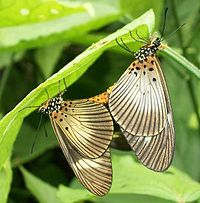- Acraea esebria
-
Dusky Acraea Acraea esebria forma monteironis Orange form male mating with female of another colour form. Scientific classification Kingdom: Animalia Phylum: Arthropoda Class: Insecta Order: Lepidoptera Family: Nymphalidae Tribe: Acraeini Genus: Acraea Species: A. esebria Binomial name Acraea esebria
Hewitson, 1861Synonyms Telchinia esebria (Hewitson, 1861)
Planema jacksoni Sharpe, 1890The Dusky Acraea (Acraea esebria) is a butterfly of the Nymphalidae family from southern and eastern Africa.
Contents
Description
The Dusky Acraea is a variable species, but the most common form is black with a white band across the forewing and a white patch on the lower forewing and on the hindwing.[1] There are a number of described morphs (with white, yellow or orange patches) including:
- f. ertli
- f. esebria
- f. protea (black with creamy-yellow patches)
- f. monteironis (black with white patches)
- f. jacksoni
The wingspan is 45–55 mm for males and 53–60 mm for females. Males and females both show the same range of colouration.[1]
Distribution
This species is found from the Eastern Cape of South Africa to Zimbabwe and in Mozambique,[1] Malawi, Zambia, southern DRC (Shaba), Angola, Tanzania and eastern Kenya (east of the Rift Valley).
Life cycle
Eggs
The eggs are oval in shape.[2]
Larvae
The larvae feed on Urtica, Laportea peduncularis, Urera trinervis, Urera hypselodendron, Obetia tenax, Pouzolzia procridioides, Pouzolzia parasitica and Fleurya mitis.[3]
Adults
Adults are on wing year round but are more common in the warmer months,[3] from December to April.[1] These butterflies fly slowly in and around forests, and feed from flowers.[1]
Gallery
References
- ^ a b c d e Williams, M. (1994). Butterflies of Southern Africa; A Field Guide. Southern Book Publishers. ISBN 1 68612 516 5.
- ^ Woodhall, S. (2008). What's that Butterfly?. Struik Publishers, Cape Town. ISBN 978 1 77007 486 6.
- ^ a b Woodhall, S. (2005) Field Guide to Butterflies of South Africa. Struik Publishers, Cape Town. ISBN 1 86872 724 6.
Categories:
Wikimedia Foundation. 2010.





